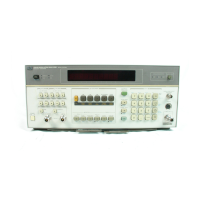General Information Model 8901B
Store and Recall functions.
These functions enable you
to
store eight complete instrument settings
in non-volatile memory and recall them
as
needed.
Display Flexibility.
The Modulation Analyzer offers numerous data-display formats. For example, RF
power can be displayed in watts, am, V, dBV, mV, dBmV, pV, and
dBpV.
Use
the RATIO and
LOG/LIN
keys
to
display results in
dB
or
7%
relative
to
either a measured value or
a
value entered from
the keyboard. These features eliminate the need for recalculating measurement results.
Special Functions
The Modulation Analyzer can do more than
is
apparent from the front panel. Many functions
are
accessed using the numeric keys and a Special Function key. The Special hctions provide access
to
other measurements and functions, manual control of instrument functions, instrument operation
verification, and service
aids.
All
instrument functions not set using these Special Functions remain in the automatic mode. This
allows you
to
select any combination of manual or automatic operations. By depressing the special
key alone, the display shows ten digits that indicate which functions are in automatic and the
state
of
those manually set.
There are also numerous Special Functions that can be used
in
verifying that the instrument and
its
various sections are operating properly. These, along with service special functions, make diagnosing
and repairing the Modulation Analyzer faster and easier.
Those Special Functions that are most commonly used in operating the Modulation Analyzer are
described on the
Special hnction Information
pull-out card under the front panel.
Extending Measurement Range
Operation
to
42
GHz
is
accomplished when an external
LO
and mixer are included
in
the measurement
path. This system then functions as a single instrument making microwave modulation, frequency,
power, and level measurements. You control operation from the Modulation Analyzer's front panel.
When the external
LO
frequency must be changed, the Modulation Analyzer requests an external
controller
to
make the change.
A
separate, non-volatile calibration factor table
is
available in Frequency
Offset mode for your microwave power sensor.
Programmability
The Modulation Analyzer
is
completely programmable
via
the Hewlett-Packard Interface Bus (HP-
IB).
This, coupled with the diversity
of
measurements the Modulation Analyzer can make, the speed
with which these measurements can be made, and the flexibility of the Special bctions, make the
instrument ideal for systems applications. In many instances
it
can reduce the number of instruments
in a system, speed measurements, reduce complexity and improve accuracy.
When the Modulation Analyzer is in remote, the front-panel annunciators make
it
very easy
to
determine the state the instrument is in; whether
it
is
in the talk, listen, or service request
state.
1-10.
PRINCIPLES
OF
OPERATION USING
A
SIMPLIFIED
BLOCK
DIAGRAM
The Modulation Analyzer
is
a calibrated, superheterodyne receiver, which converts the incoming
signal
to
a
fixed, intermediate frequency
(IF),
which
is
then demodulated.
As
in a radio receiver,
the Modulation Analyzer contains an
RF
amplifier, a local oscillator
(LO),
a
mixer, an
IF'
amplifier
and bandpass filter, a demodulator (detector or discriminator), and audio filters (tone controls). The
Modulation Analyzer, however, contains additional features which make
it
much more versatile:
automatic tuning,
selectable measurement mode: signal frequency, power level, or modulation (AM, FM, or Phase
selectable audio detector (peak, average, or
rms
responding),
audio counter,
Modulation (@MI),
1-8

